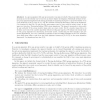Free Online Productivity Tools
i2Speak
i2Symbol
i2OCR
iTex2Img
iWeb2Print
iWeb2Shot
i2Type
iPdf2Split
iPdf2Merge
i2Bopomofo
i2Arabic
i2Style
i2Image
i2PDF
iLatex2Rtf
Sci2ools
ISW
2005
Springer
2005
Springer
Tracing-by-Linking Group Signatures
In a group signature [19], any group member can sign on behalf of the group while remaining anonymous, but its identity can be traced in an future dispute investigation. Essentially all state-of-theart group signatures implement the tracing mechnism by requiring the signer to escrow its identity to an Open Authority (OA) [2, 14, 4, 25, 5, 7, 24]. We call them Tracing-by-Escrowing (TbE) group signatures. One drawback is that the OA also has the unnecessary power to trace without proper cause. In this paper we introduce Tracing-by-Linking (TbL) group signatures. The signer’s anonymity is irrevocable by any authority if the group member signs only once (per event). But if a member signs twice, its identity can be traced by a public algorithm without needing any trapdoor. We initiate the formal study of TbL group signatures by introducing its security model, constructing the first examples, and give several applications. Our core construction technique is the successful transplant of th...
| Added | 28 Jun 2010 |
| Updated | 28 Jun 2010 |
| Type | Conference |
| Year | 2005 |
| Where | ISW |
| Authors | Victor K. Wei |
Comments (0)

